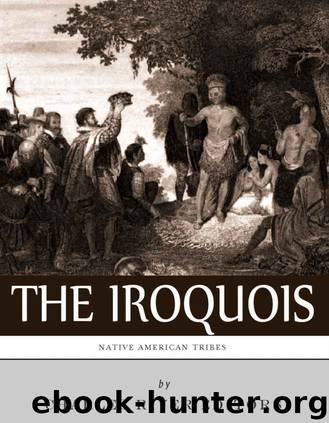Native American Tribes: The History and Culture of the Iroquois Confederacy by Charles River Editors

Author:Charles River Editors
Language: eng
Format: azw3
Published: 2012-07-16T04:00:00+00:00
Iroquois depiction of Adodarhoh receiving two Mohawk chieftains
The Great Law begins with the birth of the Peacemaker. It is told that the Peacemaker was a Wyandot named Deganawidah who was adopted by the Mohawks, and whose birth is described as a spiritually guided event. It was apparent to all that even as a youth he possessed strong spiritual power and a pacifistic philosophy, speaking at an early age of the importance of kindness and whom the Clan Mothers often called upon to address assemblies. He is widely regarded as a spiritual emissary. Still, war waged among the Iroquois in the lands to the south, and the Peacemaker set upon his journey to spread his message of peace. The Peacemaker went to the home of the esteemed Peace Woman, Yegowaneh (later renamed by the Peacemaker Jigonsaseh), and there in her longhouse he outlined his philosophy for peace between the nations. Goodwill and good behavior and mental and physical well being fostered peace among men and women, embedding a sense of social justice through the apportionment of civic rights and duties. The will of the people was considered sacred and had the backing of the organized civic voice and/or military power to enforce it.
The Great Law is a lengthy and involved document that relies heavily on symbols drawn from the everyday realities and experiences of the Iroquois people, narrated in the first person by the Peacemaker himself. It begins with the Great Tree of Peace, an actual tree that was planted in the land of the Onondaga by the Peacemaker, which he drew upon metaphorically to illustrate the principles of the Great Law. The tree is the place where the Council Fire of the Five Nations is to be conducted, sitting upon the feathery down of the globe thistle. The roots of the tree are said to extend to the four directions and are referred to as the Great White Roots, their nature being peace and strength. The root metaphor is then applied to nations outside the Five Nations who are welcomed to participate as long as they agree with the rules of the Confederacy Council. The narrative then details the organization of the Confederacy, the rules of conduct, roles of each nation and the women, official symbolisms, laws of adoption, rules of engagement for war, rights of the people, protection of religion, and other cultural considerations.
The Kaianerekowa is a political theory deeply rooted in the worldview of the Haudenosaunee. Iroquois clan systems are based on egalitarian rights and balanced political power between men and women, with women holding the positions of Clan Mothers. The Iroquois did not adhere to hierarchical power structures that relied on force in the same way that Europeans did; rather, they valued principles that respected the autonomy of the individual while also recognizing the larger importance of collaborative behavior. A sense of tribal loyalty that was tempered by intellectual independence and autonomy precluded the need for elaborate systems of control. Balance in Iroquois society was thus maintained through deeply embedded mechanisms of self−regulation.
Download
This site does not store any files on its server. We only index and link to content provided by other sites. Please contact the content providers to delete copyright contents if any and email us, we'll remove relevant links or contents immediately.
| Africa | Americas |
| Arctic & Antarctica | Asia |
| Australia & Oceania | Europe |
| Middle East | Russia |
| United States | World |
| Ancient Civilizations | Military |
| Historical Study & Educational Resources |
Cat's cradle by Kurt Vonnegut(15152)
Pimp by Iceberg Slim(14319)
4 3 2 1: A Novel by Paul Auster(12263)
Underground: A Human History of the Worlds Beneath Our Feet by Will Hunt(11997)
The Radium Girls by Kate Moore(11899)
Wiseguy by Nicholas Pileggi(5648)
Perfect Rhythm by Jae(5305)
American History Stories, Volume III (Yesterday's Classics) by Pratt Mara L(5239)
The Fire Next Time by James Baldwin(5224)
Paper Towns by Green John(5065)
Pale Blue Dot by Carl Sagan(4886)
A Higher Loyalty: Truth, Lies, and Leadership by James Comey(4822)
The Mayflower and the Pilgrims' New World by Nathaniel Philbrick(4403)
The Doomsday Machine by Daniel Ellsberg(4397)
Killers of the Flower Moon: The Osage Murders and the Birth of the FBI by David Grann(4368)
The Sympathizer by Viet Thanh Nguyen(4287)
Too Much and Not the Mood by Durga Chew-Bose(4255)
The Borden Murders by Sarah Miller(4216)
Sticky Fingers by Joe Hagan(4086)
